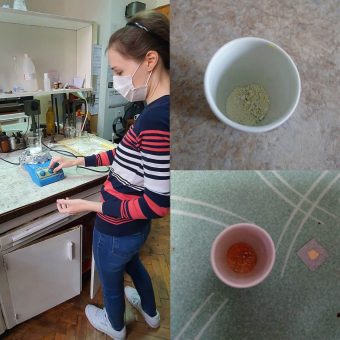
There is a massive technological appetite for lithium-ion (Li-Ion) batteries. However, their mass application is limited by lithium resources and problems related to the cost and safety of the battery due to the presence of lithium, cobalt and hazardous organic electrolyte. Scientists around the world are trying to find a better solution based on more sustainable energy storage technologies.
One Serbian team joined those efforts. Researchers from scientific research institutions such as the Faculty of Physical Chemistry, the Institute of Technical Sciences of the Serbian Academy of Sciences and Arts and the Vinca Institute of Nuclear Sciences are trying to reduce the cost of Li-Ion batteries and their weight and volume, by developing innovative electrode and electrolyte materials, and increase energy. They want to make multivalent-ion batteries, and for their development, it is necessary to obtain materials that will be able to store a large number of multivalent ions during the multiple charging and discharging process. Materials should have high specific capacities that would allow batteries to store a large amount of energy. The name of the project is HiSuperBat, and it is financed by the Science Fund of the Republic of Serbia through the Program for Excellent Projects of Young Researchers (PROMIS). Our interlocutor is Milica Vujković, the manager of the mentioned project.
EP: We are witnessing a sharp increase in public interest in electric vehicles. What is your opinion on electromobility, and how close or far are we in the Balkans from electrifying traffic?
Milica Vujković: The development of electromobility is of great importance due to the reduction of harmful gas emissions and our dependence on fossil fuels. Due to significantinvestments in this field, the number of electric cars produced has been growing exponentially in recent years, and it is almost certain that this trend will include the Balkan countries. Competition of manufacturers to maximize the mileage that vehicles can travel between two battery charges is actually a competition in innovation developed by the given companies’ research sectors. In general, research aims to reduce the price of Li-Ion batteries, their weight and volume, and increase energy by developing innovative electrode and/or electrolyte materials. However, we must also be aware that the mass production of electric cars brings with it the problems of lithium deficiency, whose reserves are constantly decreasing.
EP: What is the price-safety ratio when it comes to car batteries? How to find the way to new cheap high-security materials?
Milica Vujković: Problems related to the price and safety of the battery limit the mass production of electric cars. The limitations actually stem from the materials of which the batteries are composed, i.e. lithium and cobalt in the cathode material (each battery consists of anode, cathode material and electrolyte) and an organic electrolyte that is flammable and toxic. Therefore, materials that do not contain lithium and cobalt are necessary, while safe electrolytes would replace the dangerous ones. HiSuperBat will respond to these challenges by developing new and cost-effective high-capacity electrode materials for multivalent ion batteries (Ca, Mg or Al-ion) and supercapacitors.
In focus:
EP: What other challenges will the HiSuperBat project respond to?

Milica Vujković: The ultimate goal of the project is to develop a new, cost-effective and sustainable hybrid model for energy storage, applying the concept of hybridization of battery and supercapacitor components into one device or cell. The constructed coin-shaped model would be based on multivalent cations (Ca, Mg or Al) that are highly present on Earth and an aqueous electrolyte that would improve safety, reduce cost, and simplify the production of the storage system itself. The developed battery cell would not contain expensive and scarce lithium, flammable and toxic organic electrolyte. It would deliver specific energy higher than the corresponding lithium-ion cell and commercial water batteries (lead-acid battery, nickel-cadmium and nickel-metal hydride batteries).
EP: Are there any other advantages of a multivalent-ion battery over a lithium-ion battery?
Milica Vujković: The high price, limited resources of lithium, and Li-Ion batteries’ safety are factors that have driven researchers around the world, even in Serbia, to develop alternative solutions for energy storage. Multivalent-Ion batteries could be a great solution. Divalent Mg and Ca ions or trivalent Al ions can transfer more electrons during battery charging/ discharging than monovalent Li-Ion, which allows multivalent batteries to have a higher capacity than Li-Ion batteries. On the other hand, the interaction of electrolyte ions and electrode material during battery charging/discharging is more pronounced in the case of multivalent charge (Mg2 +, Ca2 + or Al3 +), which can cause structural collapse and thus a decrease in battery capacity. These are also obstacles that we will try to overcome within the HiSuperBat project.
Interview by: Jovana Canić
Read the whole interview in the new issue of the Energy portal Magazine CIRCULAR ECONOMY, march 2021 – may 2021.



